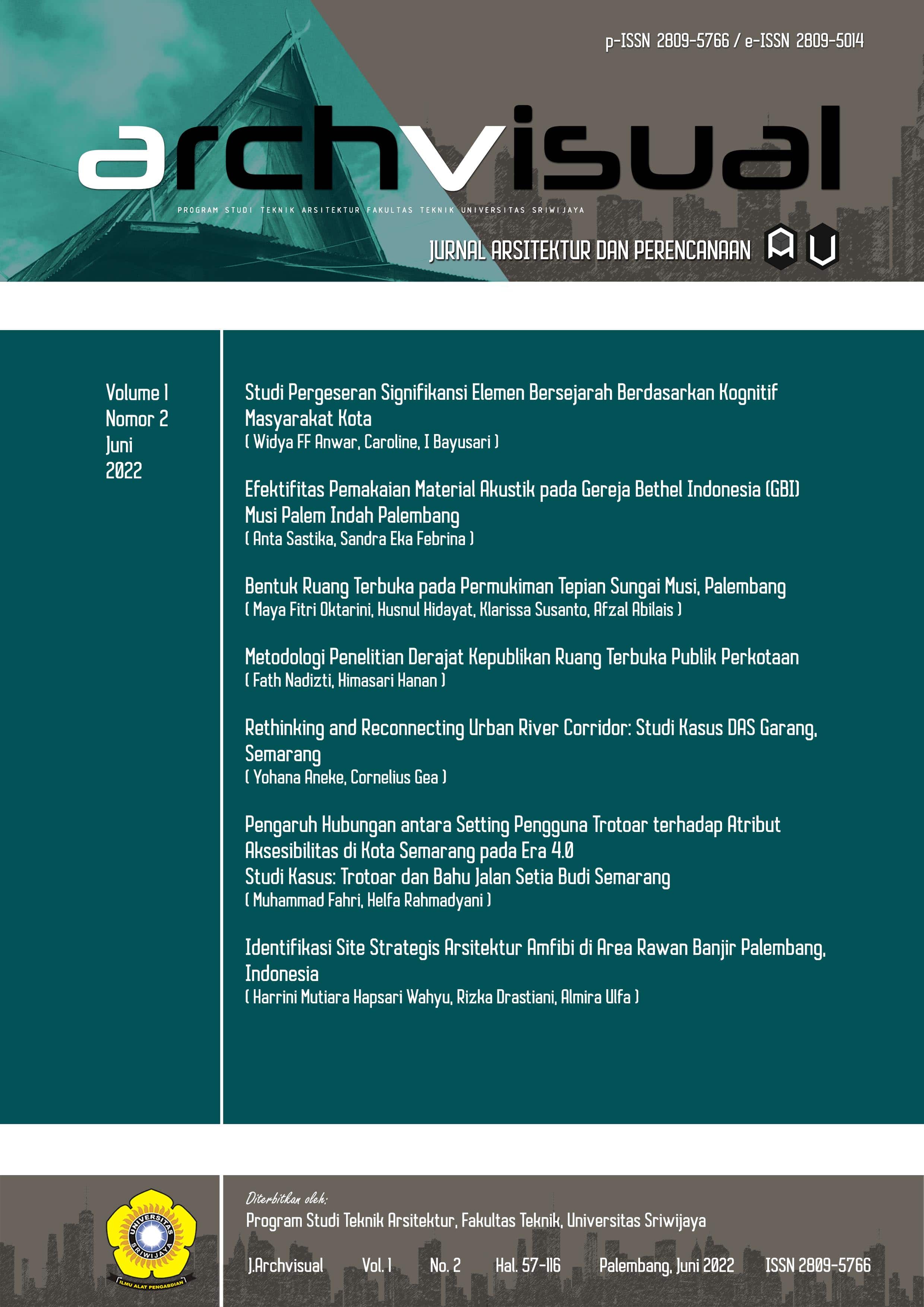Studi Pergeseran Signifikansi Elemen Bersejarah Berdasarkan Kognitif Masyarakat Kota
Main Article Content
Abstract
There are areas and historical elements of the city which can still be found physically and some physically no longer exist. In areas where the physical can still be found, the community's cognitive of its existence can still be easily detected. Things are different in historical areas where the physical elements are no longer exist. Palembang has these two situations. Previous study on the significance of city elements conducted in 2019 and 2020 shows there are 22 historical elements of the city that are important. All of them are the exists element buildings that can be found physically. Among of them, there are three elements that were the most significant in terms of memorability, imagibility, and attachment. The three elements are Kuto Besak Fort, Ampera Bridge, and the Great Mosque. This study aims to strengthen the findings by determining important historical elements and areas based on the cognitive of the urban community. This research has two objectives: (1) determine historical elements and areas; and (2) map physical and spatial patterns of elements and/or areas that are considered significant by the community. For this reason, the study mapped elements of the historical area using the mental map results from 30 respondents and then mapped it in the structure of the Palembang city map. The results confirm that these three elements are the most inherent elements in the respondents cognitive. Some of the new elements are listed in the mental map result as new city elements and old elements with new names. This study found that areas and historical elements of the city that physically still exist are more embedded in people's cognitive than those that do not exist and only remain in name (toponym). The conclusion of this study is that efforts are needed to revive the cognitive understanding of the community through reconstruction in digital form.
Article Details
Section

This work is licensed under a Creative Commons Attribution-NonCommercial 4.0 International License.
How to Cite
References
Altman, I & Low, S. (1992). Place Attachment, Hal. 1-12, Plenum Press, New York
Albert, H.C. & Hazen, H.D. (2010). Maintaining Authenticity and Integrity at Cultural World Heritage Sites. The Geographical Review, 100(1), 56-73
Anwar, W.F.F. (2013). Identification of the Morphological Characteristics of Palembang Riverside Settlement, Disertasi Doktor, School of Graduate Studies, Universiti Teknologi Malaysia
Bahar, Y. N. (2014). Aplikasi Teknologi Virtual Realty Bagi Pelestarian Bangunan Arsitektur. Jurnal Desain Konstruksi, 13(2), 34-45.
Gospodini, A. (2004). Urban Morphology and Place Identity in European Cities: Built Heritage and Innovative Design. Journal of Urban Design, 9(2), 225-248.
Graham, E. (1976). What Is a Mental Map? Area, 8(4), 259-262. Retrieved March 25, 2021,
Handal, J. (2006). Rebuilding City Identity through History: The Case of Bethlehem, Palestine. In Zetter, R. and Watson, G.B. (Ed.) Designing Sustainable Cities in Developing World, pp. 51-68. England: Ashgate
Hidayat, H. & Cahyono, A B. (2016). Rekonstruksi Digital Bangunan Candi Singosari Dengan Metode Structure from Motion Digital Reconstruction of Singosari Temple Using Structure from Motion Methods. Geoid, 11(2), 211-218
Jász, B. (2018). Mental map of the city: elements of visual argumentation and creativity in modern city planning. Creativity Studies, 11(2), 284-293.
Muchamad, B.N & Mentayani, I. (2004). Model Pelestarian Arsitektur Berbasis Teknologi Informasi, Studi kasus: Arsitektur Tradisional Suku Banjar, Dimensi Teknik Arsitektur, Vol.32(2), Hal. 95-101
Moller, V & Radolff, S.E. (2010). Monitoring Perception of Social Progress and Pride of Place in a South African Community, Applied Reseach Quality, Vol.5 hal 49-71
Oktay, D. (2002). The Quest for Urban Identity in the Changing Context of The City. Cities, 12 (4), 261-271.
Rapoport, A. (2004). Local Environment in Global Context. Proceeding of EBRA 2204 International Symposium, 1-15.
Sulistianingsih, A. S., & Kustono, D. (2022). Potensi Penggunaan Teknologi Augmented Reality (Ar) Dan Virtual Reality (Vr) Dalam Pembelajaran Sejarah Arsitektur Di Era Pandemi Covid-19. Jupiter (Jurnal Pendidikan Teknik Elektro), 7(1), 10-18.
Smaldone, D. (2006). The Role of Time in lace Attachment. Prosiding the 2006 Northeastern Recreation Research Symposium, GTR-NSR-P-14, Hal. 47-56
Swindle, J., Dorius, S., & Melegh, A. (2020). The mental map of national hierarchy in Europe. International journal of sociology, 50(3), 179-200.
Toha, Rayuna. (2018). Pengembangan Mental Map Dalam Pembelajaran Geografi Di Sekolah. Jurnal SPATIAL Wahana Komunikasi dan Informasi Geografi. 18. 84-94. 10.21009/spatial.182.02.
Wang, S.Y. (2010). In Search of Authenticity in Historic Cities in Transformation, the Case of Pingyao, China. Asian Research Institute Working Paper Series, No. 133: ARI, NUS.
Watson, B & Bentley. (2007). Identity by Design; Elsevier Ankum, P., Koga, K., Segeren, W.A. and Luijendeijk, J. (1988). Lessons from 1200 years impoldering in the Netherlands. Proc. Int. Symposium

